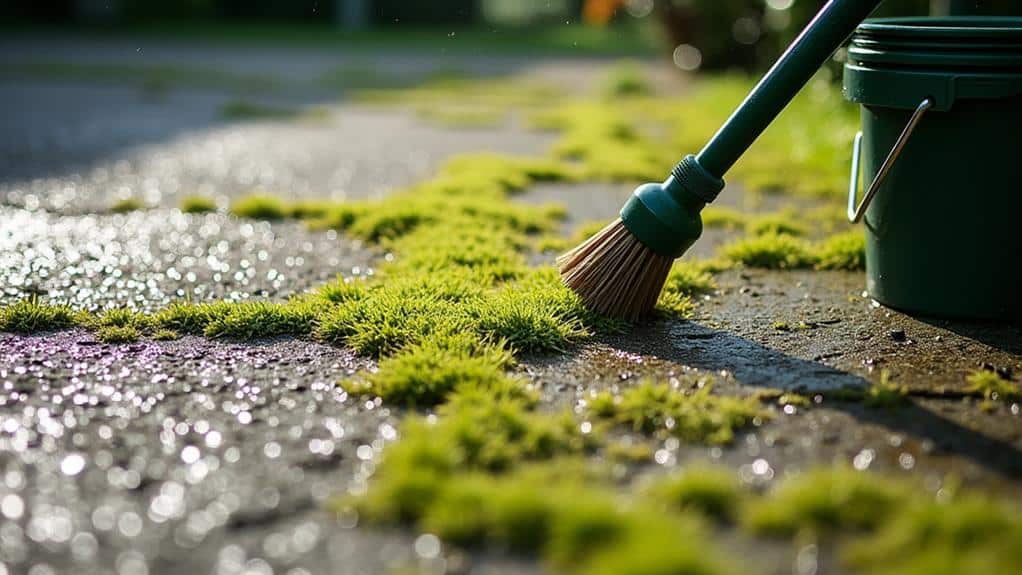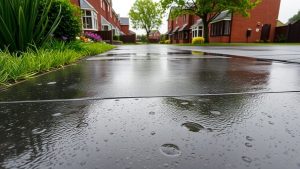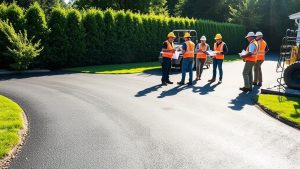To clean and maintain your tarmac driveway, start by clearing debris and sweeping the surface. Use a pressure washer with a specialized tarmac cleaner to remove dirt and stains. Pre-treat oil spots with a degreaser, and address moss or algae with a bleach solution. Scrub stubborn areas with a stiff-bristled brush, then rinse thoroughly. Allow the surface to dry completely before applying a sealant. Regular maintenance, including seasonal cleaning and prompt stain removal, is essential for preserving your driveway’s appearance and integrity. By following these steps and addressing specific issues as they arise, you’ll guarantee your tarmac driveway remains in top condition for years to come.
Table of Contents
ToggleKey Takeaways
- Regularly sweep and remove debris to prevent buildup and maintain appearance.
- Pre-treat stains with appropriate cleaners before scrubbing with a stiff-bristled brush.
- Use a pressure washer to clean the entire surface, working from high to low areas.
- Apply a tarmac-specific sealant after cleaning to protect against weathering and stains.
- Address cracks and potholes promptly to prevent further deterioration of the driveway surface.
Introduction
Tarmac driveways, constructed from a mixture of tar and aggregate materials, provide a durable and cost-effective surface for vehicle parking and access.
While tarmac is known for its affordability, it may require more frequent repairs compared to alternative materials like resin.
Regular cleaning and maintenance of your tarmac driveway are essential to preserve its appearance, extend its lifespan, and prevent costly repairs.
You’ll need to implement proper care techniques to protect your investment and guarantee your driveway remains functional and aesthetically pleasing for years to come.
Brief explanation of tarmac driveways
While many homeowners opt for concrete or gravel, tarmac driveways have gained popularity due to their durability and cost-effectiveness. Tarmac, also known as asphalt, is a mixture of aggregate materials and bitumen that creates a smooth, flexible surface. This composition allows tarmac to withstand heavy loads and resist cracking, making it ideal for driveways.
Quick installation is another advantage of tarmac driveways, with most projects completed in just one day.
To maintain tarmac driveway longevity, regular cleaning and maintenance are essential. The tarmac driveway cleaning process involves removing debris, oil stains, and moss growth.
Proper tarmac driveway care includes addressing cracks promptly and applying sealant every few years. By implementing a consistent tarmac driveway maintenance routine, you’ll protect your investment and extend its lifespan.
Understanding the unique properties of tarmac will help you tailor your cleaning and maintenance approach, ensuring your driveway remains attractive and functional for years to come.
Importance of regular cleaning and maintenance
Regular cleaning and maintenance are fundamental to preserving the integrity and appearance of your tarmac driveway. Adhering to a tarmac maintenance guide guarantees longevity and prevents costly repairs.
Seasonal tarmac maintenance is vital, as weather changes can impact your driveway’s condition. The importance of driveway cleaning extends beyond aesthetics; it prevents the buildup of harmful substances that can degrade the surface.
Professional installation by experienced teams guarantees a durable foundation for your tarmac driveway, making maintenance easier and more effective in the long run. Tarmac’s low maintenance nature is one of its key advantages, but proper care is still essential to maximize its lifespan.
Best practices for tarmac care include:
- Regular sweeping and pressure washing
- Prompt removal of oil spills and stains
- Applying sealant every 3-5 years
Understanding Tarmac Driveways
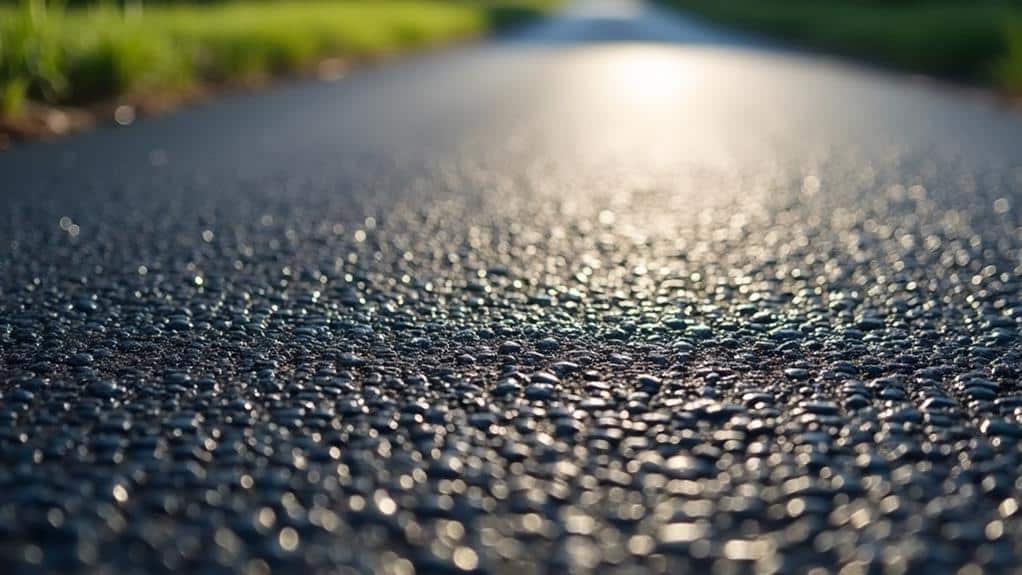
Tarmac, a durable mixture of tar and aggregate, forms a resilient surface for driveways.
You’ll find that tarmac’s composition allows it to withstand heavy loads and resist weathering, but it’s not impervious to all issues.
Common problems affecting tarmac driveways include cracking, oil stains, weed growth, and surface deterioration due to UV exposure.
Composition and properties of tarmac
Understanding the composition and properties of tarmac is essential for proper driveway maintenance. Tarmac, a mixture of aggregate and bitumen, offers unique characteristics that influence its care. The bitumen acts as a binder, creating a flexible yet durable surface.
To effectively maintain your tarmac driveway, consider these key properties:
- Porosity: Tarmac’s porous nature allows water penetration, requiring proper drainage
- Temperature sensitivity: Extreme heat can soften tarmac, while cold can make it brittle
- Chemical reactivity: Certain substances can dissolve or damage the bitumen binder
Knowing these properties will help you implement the best way to clean tarmac and prevent damage.
Regular sweeping, prompt stain removal, and avoiding harsh chemicals are essential tarmac surface care practices. For tarmac preservation tips, focus on sealing the surface periodically and addressing cracks promptly.
Common issues affecting tarmac driveways
Despite its durability, your tarmac driveway can face several common issues over time.
Tarmac driveway problems include surface cracking, potholes, and edge deterioration due to weather exposure and heavy vehicle traffic.
Cleaning tarmac stains becomes necessary when oil, grease, or fuel spills occur, potentially leading to surface degradation if left untreated.
Tarmac discoloration solutions are often required to address fading or uneven coloration caused by UV radiation and chemical reactions.
Removing dirt from tarmac is vital to prevent the accumulation of debris that can trap moisture and accelerate wear.
Cleaning driveway algae is essential, as these organisms thrive in damp conditions and can create slippery surfaces.
Regular maintenance, including sweeping, power washing, and applying sealants, can mitigate these issues and extend the lifespan of your tarmac driveway.
Preparing for Cleaning
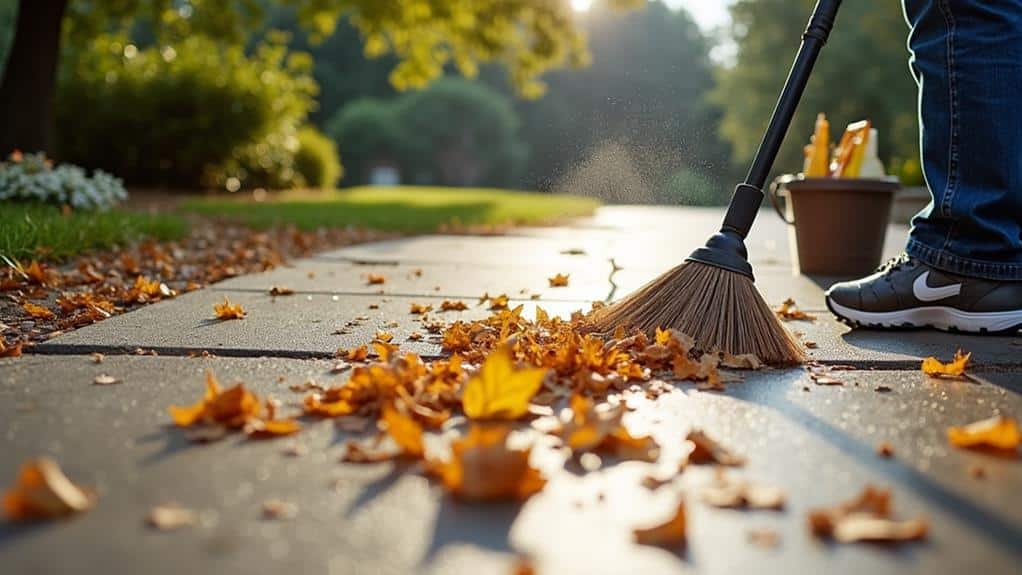
Before cleaning your tarmac driveway, gather essential tools and materials such as a stiff-bristled brush, pressure washer, detergent, and protective gear.
Confirm you have appropriate safety equipment, including gloves, eye protection, and non-slip footwear.
Familiarize yourself with the manufacturer’s instructions for any cleaning products or equipment you’ll be using, and take necessary precautions to protect surrounding vegetation and surfaces from chemical runoff.
Tools and materials needed
To effectively clean and maintain your tarmac driveway, you’ll need to gather the right tools and materials. Essential items for tarmac cleaning include:
- A high-pressure washer
- Tarmac-specific cleaning solutions
- Stiff-bristled brushes
You’ll also require protective gear like gloves and safety goggles. For stubborn stains, specialized tarmac cleaning products may be necessary.
A leaf blower or sturdy broom will help remove loose debris before washing. If you’re planning to seal the tarmac after cleaning, make sure you have an appropriate sealant on hand. Don’t forget buckets for mixing cleaning solutions and rinsing.
When selecting pressure washing equipment for tarmac, opt for a model with adjustable pressure settings to avoid damaging the surface.
Choose cleaning solutions specifically formulated for tarmac to achieve the best results without compromising the material’s integrity.
Safety precautions
Safety should be your top priority when preparing to clean your tarmac driveway. When using a pressure washer on tarmac, wear protective eyewear, gloves, and non-slip footwear to guard against debris and chemical splashes.
Ascertain your cleaning equipment for tarmac is in good working order, with no frayed cords or leaks. Before starting, clear the area of obstacles and inform others to stay clear.
Follow the dos and don’ts of tarmac cleaning: do test the pressure washer on a small, inconspicuous area first; don’t use excessive pressure, which can damage the surface.
Adhere to best practices for tarmac maintenance by reading all product labels and following manufacturer instructions for cleaning solutions and equipment. When handling chemicals, work in a well-ventilated area and avoid skin contact.
Always keep children and pets away from the work zone during the cleaning process.
Step-by-Step Cleaning Process

Begin your tarmac driveway cleaning process by thoroughly clearing debris and loose dirt, followed by pre-treating any stubborn stains or problem areas.
Apply an appropriate cleaning solution evenly across the surface, utilizing effective scrubbing techniques to dislodge embedded grime.
Complete the process by thoroughly rinsing the driveway, ensuring all cleaning agents and loosened dirt are completely removed.
Clearing debris and loose dirt
Before starting on the main cleaning process, you’ll need to clear your tarmac driveway of debris and loose dirt. This vital step in your tarmac cleaning checklist guarantees effective cleaning and prevents damage to your driveway’s surface.
Begin by thoroughly sweeping the entire area with a stiff-bristled broom, paying close attention to corners and edges where debris often accumulates.
For a thorough DIY tarmac cleaning approach, follow these steps:
- Remove larger debris like leaves, twigs, and stones by hand or with a leaf blower
- Use a pressure washer on a low setting to dislodge stubborn dirt and grime
- Sweep or rinse away any remaining loose particles
This initial clearing phase is essential for proper tarmac maintenance and sets the foundation for a successful step-by-step tarmac cleaning process.
Pre-treating stains and problem areas
Once you’ve cleared the debris and loose dirt, it’s essential to address any stains or problem areas on your tarmac driveway.
To remove oil stains from tarmac, apply a commercial degreaser or a mixture of dish soap and hot water. Let it sit for 15-20 minutes, then scrub vigorously with a stiff-bristled brush.
For stubborn tarmac marks, use a specialized tarmac cleaner or a solution of trisodium phosphate and water. When cleaning oil spills on tarmac, act quickly by blotting the excess oil with absorbent materials like cat litter or sawdust.
To treat tarmac stains effectively, use a pressure washer on a low setting to avoid damaging the surface. For persistent stains, repeat the process or consider using a poultice made from a cleaning agent and an absorbent material.
Always test cleaning solutions on a small, inconspicuous area first.
Applying cleaning solution
After addressing stains and problem areas, you’re ready to apply the cleaning solution to your tarmac driveway.
Choose an eco-friendly tarmac cleaning product or create a natural tarmac cleaner using a mixture of water and mild detergent. For professional-grade results, consider specialized driveway cleaners formulated for tarmac surfaces.
Apply the cleaning solution using one of these methods:
- Pressure washer with a fan nozzle attachment
- Long-handled brush for manual scrubbing
- Professional tarmac cleaning equipment for large areas
Work in small sections, starting from the highest point of your driveway and moving downward. Maintain consistent coverage to guarantee uniform cleaning.
Allow the solution to sit for 5-10 minutes, but don’t let it dry completely. For stubborn areas, gently agitate the surface with a brush.
Rinse thoroughly with clean water, working in the same pattern as the initial application.
Scrubbing techniques
Effective scrubbing techniques are essential for achieving a thorough clean on your tarmac driveway.
Begin by using a stiff-bristled brush or broom to apply pressure in circular motions, focusing on stubborn stains and greasy spots. For heavily soiled areas, employ a scrubbing brush with harder bristles to break down grime effectively.
When dealing with oil or grease, use a degreaser or specialized tarmac cleaner before scrubbing. For general cleaning, a mixture of water and mild detergent works well. Make certain you’re using the best cleaning agents for tarmac to avoid damage.
Work in small sections, overlapping slightly to maintain consistency. For larger driveways, consider using a power washer with an appropriate nozzle to enhance your scrubbing efforts.
Remember to rinse thoroughly after scrubbing to remove all cleaning solution and loosened debris.
Rinsing methods
The hose stands ready as your primary tool for the rinsing phase of tarmac cleaning.
Begin at the highest point of your driveway, working methodically downward to guarantee thorough removal of grime from tarmac. Utilize a high-pressure nozzle attachment for best results, maintaining a consistent distance of about 30 cm from the surface.
For best ways to clean tarmac and maintain proper driveway cleaning frequency, consider these rinsing methods:
- Overlapping strokes: Move side-to-side, overlapping each pass by 15 cm
- Angled approach: Direct water at a 45-degree angle for improved debris removal
- Sectional cleaning: Divide the driveway into manageable areas, rinsing each thoroughly
Adjust your tarmac driveway cleaning frequency based on environmental factors and usage.
Typically, a thorough rinse every 3-6 months suffices, but high-traffic areas may require more frequent attention to maintain best condition and appearance.
Drying recommendations
With the rinsing phase complete, proper drying is the next step in maintaining your tarmac driveway. Allow natural air drying whenever possible, as it’s the most effective method for tarmac driveway restoration. If time is of the essence, use a leaf blower or soft-bristled push broom to accelerate the process. Confirm the surface is completely dry before proceeding with any sealant application.
| Season | Drying Recommendation |
|---|---|
| Spring | Natural air drying |
| Summer | Leaf blower assistance |
| Fall | Push broom method |
| Winter | Heated air blower |
| All Seasons | Avoid foot traffic |
For ideal surface preparation for tarmac, remove any remaining debris or standing water. This step is vital before applying sealant to tarmac, as moisture can compromise the sealant’s effectiveness. In tarmac cleaning FAQs, proper drying is often emphasized as a key component of seasonal driveway care, confirming longevity and maintaining the driveway’s appearance.
Dealing with Specific Issues
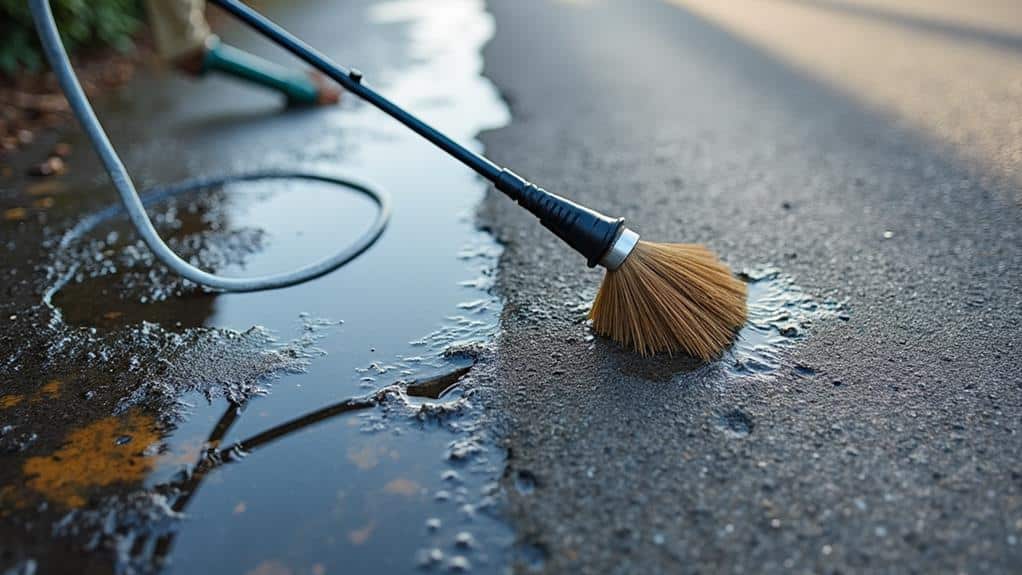
Your tarmac driveway may face specific challenges that require targeted solutions.
You’ll need to address oil and grease stains, moss and algae growth, paint spills, and stubborn marks using appropriate techniques and products.
This section will guide you through effective methods for tackling these common issues, ensuring your driveway remains clean and well-maintained.
Removing oil and grease stains
On tarmac driveways, oil and grease stains can be particularly stubborn and unsightly. To effectively remove these blemishes, follow these best driveway maintenance practices:
- Apply a commercial degreaser or dish soap directly to the stain
- Scrub vigorously with a stiff-bristled brush
- Rinse thoroughly with hot water
For persistent stains, consider using a poultice made from cat litter or baking soda mixed with water. Apply the paste to the affected area, cover with plastic wrap, and leave for 24 hours before removing.
To prevent future stains, apply a tarmac driveway sealer annually. This protective layer will also help you avoid having to fix tarmac cracks later.
Tackling moss and algae growth
Many tarmac driveways are susceptible to moss and algae growth, particularly in damp or shaded areas. To tackle this issue, start by removing loose debris with a stiff brush.
For effective moss removal from tarmac, apply a specialized driveway moss treatment or a mixture of water and bleach. Allow the solution to sit for 15-20 minutes before scrubbing vigorously. Rinse thoroughly with a pressure washer, being careful not to damage the tarmac surface.
For long-term tarmac driveway upkeep, consider these seasonal tips:
In spring, apply a moss inhibitor to prevent regrowth.
During summer, keep the surface clean and dry.
In autumn, remove fallen leaves promptly to prevent moisture accumulation.
In winter, avoid using salt for de-icing, as it can damage the tarmac. Instead, use sand or gravel for traction.
Regular maintenance will help you effectively clear moss from your driveway and preserve its appearance.
Addressing paint spills
While moss and algae are common issues, paint spills on tarmac driveways can be particularly challenging. Addressing paint spills promptly is vital for effective tarmac driveway upkeep.
To remove paint from tarmac, follow these steps:
- Use a paint scraper to remove as much dried paint as possible
- Apply a commercial paint remover designed for tarmac surfaces
- Scrub the area with a stiff-bristled brush and rinse thoroughly
For stubborn paint stains, consider using a pressure washer or seeking professional assistance.
When repairing tarmac driveways affected by paint spills, it’s essential to assess the damage and determine if patching is necessary.
To keep your tarmac driveway in shape, regularly inspect for paint spills and address them immediately.
Handling stubborn marks
Although regular cleaning can address most stains on your tarmac driveway, stubborn marks often require special attention.
For heavy vehicle tarmac care, use a degreaser to remove oil and fuel stains. Scrub the area with a stiff brush and rinse thoroughly.
When restoring faded tarmac, apply a specialized tarmac restorer to rejuvenate the surface’s color and protect it from further damage.
To fix cracks in tarmac, clean the area, fill with a tarmac repair compound, and compact it firmly.
For major tarmac cleaning issues like ingrained dirt or algae growth, use a pressure washer with a specialized tarmac cleaner. Remember to test any cleaning solution on a small, inconspicuous area first.
After addressing stubborn marks, consider applying a sealant to protect your tarmac from future stains and extend its lifespan.
Advanced Cleaning Techniques

For advanced cleaning of your tarmac driveway, consider using a pressure washer with caution.
You’ll need to maintain a safe distance and use appropriate pressure settings to avoid damaging the surface.
If you’re unsure about tackling the job yourself, professional cleaning services offer specialized equipment and expertise for thorough, safe tarmac maintenance.
Using pressure washers safely
Three key safety considerations are essential when using a pressure washer on your tarmac driveway.
First, always wear protective gear, including safety goggles and sturdy footwear.
Second, maintain a safe distance of at least 12 inches between the nozzle and the surface to prevent damage.
Third, use the appropriate pressure setting for tarmac, typically between 1500-2000 PSI.
To guarantee long-term tarmac maintenance and avoid damage:
- Clean your driveway at least twice a year, more frequently during winter
- Use a wide-angle nozzle to distribute pressure evenly
- Work in sections, moving the spray in a consistent pattern
Professional cleaning options
While regular maintenance can keep your tarmac driveway in good condition, professional cleaning services offer advanced techniques for deeper, more thorough cleaning.
These experts employ specialized equipment and eco-friendly chemicals to remove stubborn stains, restore tarmac color, and prevent weed growth on tarmac. They’ll often use high-pressure steam cleaning, which effectively lifts dirt and grime without damaging the surface.
To protect tarmac from weeds, professionals may apply selective herbicides or install root barriers. For sustainable tarmac maintenance, they might recommend permeable solutions that allow water drainage.
When considering whether you should seal tarmac, professionals can assess your driveway’s condition and apply appropriate sealants to extend its lifespan. They’ll also address any structural issues, ensuring your driveway remains functional and aesthetically pleasing for years to come.
Maintenance and Protection

Implement a regular cleaning schedule to maintain your tarmac driveway’s appearance and longevity.
Apply sealants and restorers periodically to protect the surface from weathering and chemical damage.
Take precautions to prevent excessive wear from heavy vehicles, such as using plywood sheets to distribute weight when parking large equipment.
Regular cleaning schedule
Establishing a consistent cleaning routine is essential for maintaining the appearance and longevity of your tarmac driveway. Implement a weekly schedule that includes sweeping debris and removing stains promptly.
For more thorough cleaning, pressure wash your driveway every three to six months, depending on its exposure to dirt and pollutants.
Incorporate these key elements into your regular cleaning schedule:
- Sweep the surface using a stiff-bristled broom to remove loose debris
- Spot-clean oil stains with a specialized tarmac cleaner and scrub brush
- Rinse the entire driveway with a garden hose or pressure washer
During autumn, increase the frequency of leaf removal to prevent staining and moss growth.
In winter, promptly clear snow and ice to avoid surface damage. By adhering to a consistent cleaning regimen, you’ll extend your tarmac driveway’s lifespan and maintain its aesthetic appeal.
Applying sealants and restorers
To seal the deal on your tarmac driveway’s longevity, applying sealants and restorers is essential. Begin by thoroughly cleaning the surface and guaranteeing it’s completely dry.
Choose a high-quality tarmac sealant that’s compatible with your driveway’s composition. Apply the sealant using a roller or sprayer, working in small sections to guarantee even coverage. Allow each coat to dry completely before applying subsequent layers.
For restoring faded or oxidized tarmac, use a specialized restorer product. These typically contain oils and resins that penetrate the surface, revitalizing its appearance and protective properties.
Apply the restorer following the manufacturer’s instructions, usually with a brush or roller. Be sure to work the product into any cracks or porous areas.
Reapply sealants and restorers every 3-5 years, or as recommended by the product manufacturer, to maintain peak protection.
Preventing damage from heavy vehicles
Despite its durability, a tarmac driveway can suffer damage from heavy vehicles if proper precautions aren’t taken. To prevent such damage, implement the following measures:
- Install edge restraints to distribute weight and prevent cracking
- Use load-spreading plates under vehicle jacks or outriggers
- Avoid parking heavy vehicles in the same spot repeatedly
When receiving deliveries or accommodating construction equipment, make sure drivers are aware of weight restrictions.
If possible, direct heavy vehicles to reinforced areas of your driveway designed to handle increased loads. For long-term parking of heavy vehicles, consider creating a designated area with additional support, such as a concrete pad or reinforced tarmac section.
Regularly inspect your driveway for signs of stress or damage, particularly in areas where heavy vehicles frequently traverse.
Seasonal Care
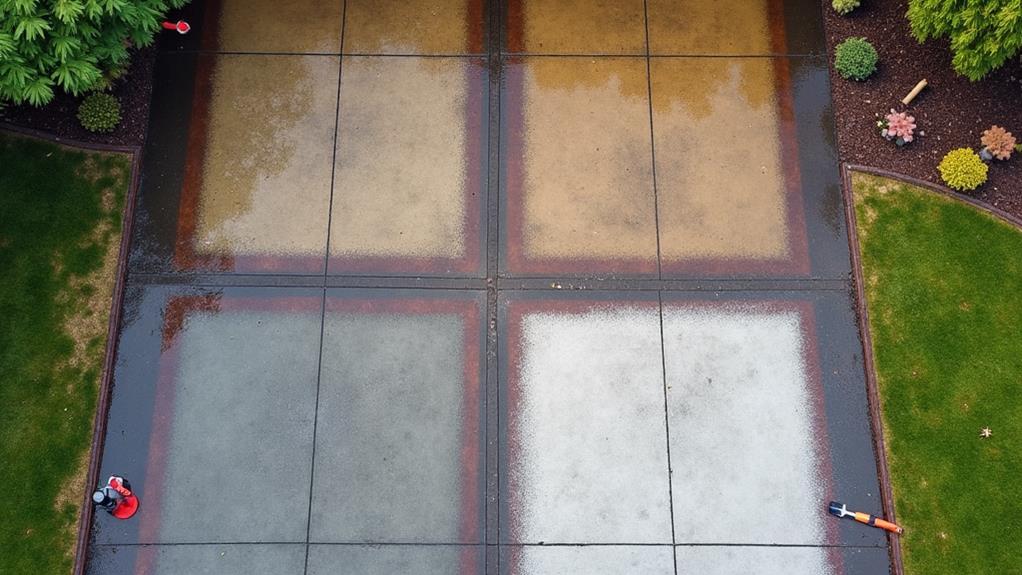
Your tarmac driveway requires specific care as seasons change.
In summer, you’ll need to protect the surface from UV damage and softening due to high temperatures.
Winter demands vigilance against frost damage, ice formation, and the corrosive effects of road salt on your tarmac.
Summer maintenance tips
Summer presents unique challenges for tarmac driveway maintenance. High temperatures can soften the surface, making it more susceptible to damage. To protect your driveway, implement these essential measures:
- Apply a protective sealant to prevent UV damage and repel oil stains
- Regularly remove debris and vegetation to prevent surface degradation
- Avoid parking heavy vehicles in the same spot for extended periods
During hot weather, it’s vital to address any cracks or potholes promptly. Use a tarmac repair compound for small issues, but consult professionals for significant damage.
Minimize the use of chemical de-icers, as they can accelerate surface deterioration. Instead, opt for sand or fine gravel for traction.
Keep your driveway cool by occasionally spraying it with water during extreme heat waves. This practice helps maintain the tarmac’s structural integrity and prolongs its lifespan.
Winter protection strategies
As winter approaches, protecting your tarmac driveway from harsh weather conditions becomes paramount.
Start by thoroughly cleaning the surface and applying a high-quality sealant to prevent water penetration. This barrier will shield against freeze-thaw cycles that can cause cracking.
Remove snow promptly using plastic shovels or rubber-tipped plows to avoid surface damage. Avoid using metal tools, which can scratch the tarmac.
Apply a thin layer of sand or fine gravel for traction, steering clear of rock salt or chemical de-icers that can erode the surface. If ice forms, use a calcium chloride-based de-icer sparingly.
Install drainage solutions to prevent water pooling, which can lead to frost heave. Regularly inspect for cracks or damage, addressing issues promptly to prevent further deterioration.
Troubleshooting Common Problems
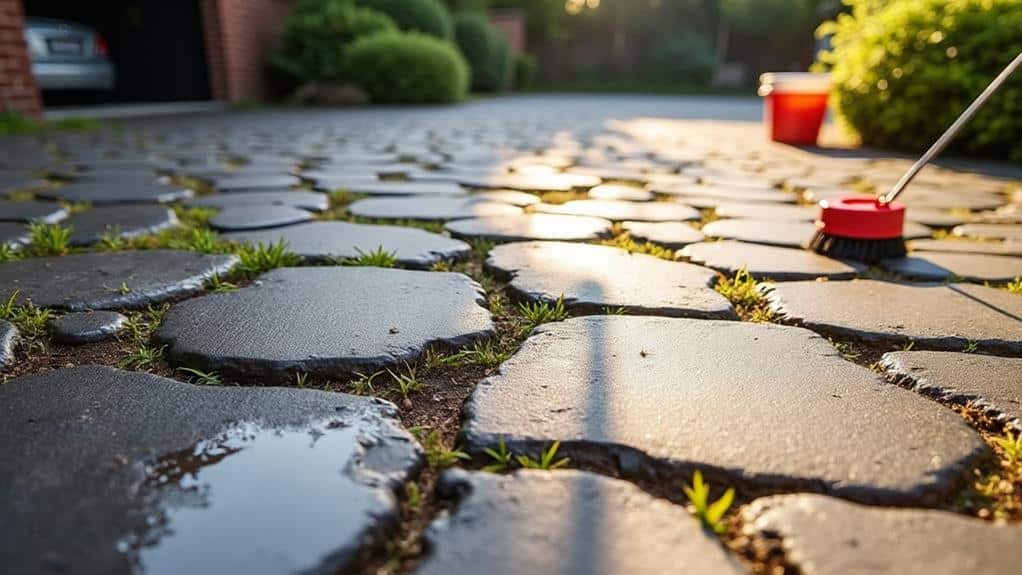
Your tarmac driveway may develop issues over time, including cracks, potholes, fading, discoloration, and weed growth.
These problems can compromise the appearance and functionality of your driveway if left unaddressed.
You’ll need to identify and tackle these issues promptly to maintain your driveway’s integrity and extend its lifespan.
Cracks and potholes
Cracks and potholes are common issues that can considerably degrade the appearance and functionality of your tarmac driveway. These problems often result from water infiltration, freeze-thaw cycles, or heavy vehicle traffic.
To address these issues effectively:
- For small cracks, use a tarmac crack filler and smooth it with a trowel.
- For larger cracks or potholes, clean the area thoroughly and apply a cold lay tarmac repair compound.
- For extensive damage, consider professional resurfacing.
Prevention is key to maintaining your tarmac driveway’s integrity. Regularly inspect for early signs of damage and address them promptly.
Guarantee proper drainage to prevent water accumulation, which can lead to crack formation. Apply a high-quality tarmac sealant every 3-5 years to protect the surface from UV rays and water penetration.
Fading and discoloration
Why does a once-pristine tarmac driveway lose its deep, rich color over time? Fading and discoloration occur primarily due to UV radiation exposure and oxidation.
The sun’s rays break down the bitumen binder in tarmac, causing it to lose its original hue and become lighter. Additionally, prolonged exposure to oxygen leads to chemical changes in the surface, further contributing to color loss.
To address this issue, you’ll need to apply a tarmac sealer or rejuvenator. These products penetrate the surface, restoring the lost oils and protecting against further UV damage.
Before application, thoroughly clean your driveway and repair any cracks or damage. Apply the sealer evenly using a roller or sprayer, following the manufacturer’s instructions.
For best results, reapply every 3-5 years, depending on your climate and driveway usage. Regular sealing will maintain your tarmac’s appearance and extend its lifespan.
Weed growth
Three primary factors contribute to weed growth in tarmac driveways: cracks, poor drainage, and inadequate maintenance.
To prevent and address weed issues, you’ll need to tackle these root causes systematically. Start by sealing any cracks in your tarmac surface, as these provide entry points for seeds and moisture.
Improve drainage by ensuring proper slope and installing adequate drainage systems if necessary.
To combat existing weeds and prevent future growth:
- Apply a targeted herbicide to kill current weeds
- Use a weed membrane beneath the tarmac during installation or repairs
- Regularly sweep and clean your driveway to remove seeds and debris
When to Seek Professional Help

While regular maintenance can address most tarmac issues, certain signs indicate the need for professional intervention.
You’ll want to consult experts if you observe extensive cracking, significant drainage problems, or large areas of deterioration that DIY methods can’t resolve.
When selecting a tarmac cleaning service, prioritize companies with proven experience, proper equipment, and positive customer reviews to guarantee your driveway receives expert care.
Signs that indicate professional intervention is needed
Recognizing when to seek professional help for your tarmac driveway is essential for maintaining its longevity and appearance.
Be vigilant for these vital signs that indicate professional intervention is necessary:
- Significant cracks or fissures exceeding 1/4 inch in width
- Multiple potholes or sunken areas across the surface
- Widespread oil stains that have penetrated deeply into the tarmac
If you notice extensive surface damage, such as large areas of crumbling or flaking, it’s time to consult an expert.
Professionals can assess the extent of the damage and determine whether repairs or resurfacing are required.
Additionally, if you observe poor drainage issues leading to water pooling on your driveway, it’s vital to address this promptly.
Persistent standing water can accelerate deterioration and compromise the structural integrity of your tarmac.
Don’t hesitate to seek professional assistance when these signs appear.
Choosing a reputable tarmac cleaning service
Selecting a reputable tarmac cleaning service is crucial when professional intervention becomes necessary.
Begin your search by requesting recommendations from neighbors or local community groups. Research potential companies online, focusing on their experience, certifications, and customer reviews. Verify they’re licensed, insured, and use eco-friendly cleaning products.
Request detailed quotes from at least three providers, specifying the scope of work and any additional services required. Ask about their equipment, techniques, and safety measures. Inquire about warranties or guarantees for their work.
Don’t automatically choose the lowest bid; consider the overall value and quality of service. Schedule an on-site assessment to allow the professionals to evaluate your driveway’s condition and provide an accurate estimate.
Eco-Friendly Cleaning Options
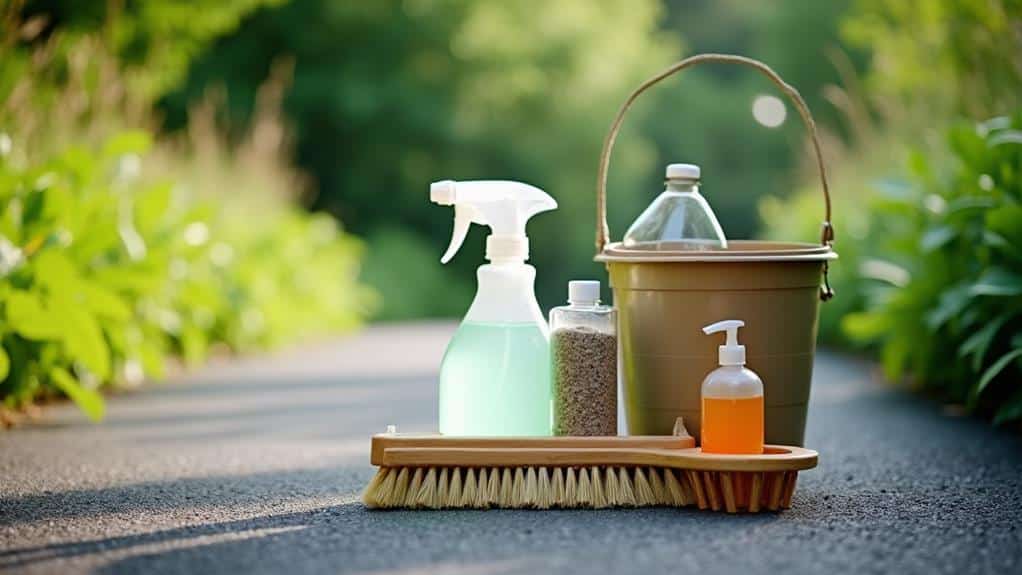
When considering eco-friendly cleaning options for your tarmac driveway, natural cleaning solutions offer effective alternatives to harsh chemicals.
You can create your own environmentally conscious cleaning mixtures using common household items like vinegar, baking soda, and lemon juice.
These natural solutions not only protect the environment but also maintain the integrity of your tarmac surface while minimizing potential harm to surrounding vegetation and wildlife.
Natural cleaning solutions
Eco-conscious homeowners can opt for natural cleaning solutions to maintain their tarmac driveways without harming the environment.
These alternatives are effective and biodegradable, minimizing ecological impact. Consider using a mixture of white vinegar and water in a 1:1 ratio for general cleaning and stain removal. For tougher stains, create a paste using baking soda and water. Apply it to the affected area, let it sit for 15 minutes, then scrub and rinse thoroughly.
Natural cleaning solutions offer several benefits:
- They’re non-toxic and safe for pets and children
- They’re cost-effective compared to commercial cleaners
- They don’t contribute to chemical runoff in waterways
When using natural cleaners, always test on a small, inconspicuous area first to verify compatibility with your tarmac surface.
Regular application of these eco-friendly solutions will help maintain your driveway’s appearance and longevity while protecting the environment.
Environmentally conscious practices
Beyond natural cleaning solutions, you can adopt several environmentally conscious practices to maintain your tarmac driveway.
Implement a regular sweeping routine to prevent debris accumulation, reducing the need for harsh chemicals. Use permeable pavers or install drainage systems to manage rainwater runoff, minimizing erosion and pollutant transport.
When sealing your driveway, opt for water-based, low-VOC sealants to reduce harmful emissions. Consider installing rain gardens or bioswales adjacent to your driveway to naturally filter runoff.
For de-icing in winter, use sand or kitty litter instead of salt, which can damage tarmac and harm vegetation. Collect and properly dispose of any oil or fuel spills immediately to prevent groundwater contamination.
When repairs are necessary, choose recycled asphalt materials to reduce your carbon footprint.
Conclusion
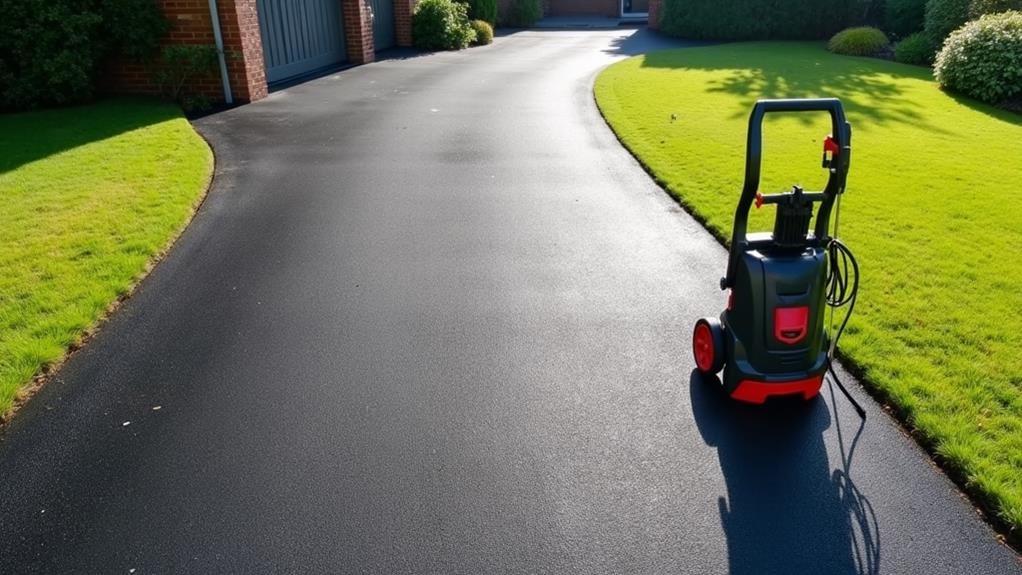
Proper maintenance of your tarmac driveway involves regular cleaning, prompt repairs, and protective measures.
You’ll benefit from improved curb appeal, extended driveway lifespan, and reduced long-term costs by following the outlined cleaning and care techniques.
Remember that consistent upkeep not only preserves your driveway’s appearance but also enhances its durability and functionality for years to come.
Recap of key points
Maintenance of your tarmac driveway is essential for its longevity and appearance.
Regular cleaning, sealing, and prompt repairs are vital for preserving its integrity.
Remember these key points:
- Clean your driveway at least twice a year using a pressure washer or stiff-bristled brush
- Apply a high-quality sealant every 3-5 years to protect against UV rays and water damage
- Address cracks, potholes, and other damages immediately to prevent further deterioration
Long-term benefits of proper tarmac driveway care
With diligent care and maintenance, your tarmac driveway can provide numerous long-term benefits.
You’ll greatly extend its lifespan, potentially doubling its durability from the standard 15-20 years to 30-40 years. Proper upkeep guarantees the surface remains smooth and even, reducing the risk of trip hazards and vehicle damage.
You’ll also maintain ideal water drainage, preventing pooling and subsequent damage to the substrate.
Regular cleaning and sealing preserve the driveway’s aesthetics, enhancing your property’s curb appeal and potentially increasing its value.
You’ll minimize the need for costly repairs or premature resurfacing, saving substantial amounts in the long run.
Additionally, a well-maintained tarmac surface is more resistant to oil stains, UV damage, and weed growth.
Frequently Asked Questions
Can I Use a Pressure Washer on My Tarmac Driveway?
Yes, you can use a pressure washer on your tarmac driveway. However, you’ll need to exercise caution. Use a wide-angle nozzle and maintain a distance of at least 12 inches to avoid damaging the surface. Start with lower pressure settings.
How Often Should I Reseal My Tarmac Driveway?
Did you know 90% of tarmac driveways last longer with proper resealing? You should reseal your tarmac driveway every 3-5 years. Factors like weather, usage, and initial installation quality can influence this frequency. Always assess your driveway’s condition annually.
Is It Safe to Use Salt on Tarmac Driveways During Winter?
You shouldn’t use salt on your tarmac driveway. It’ll cause surface deterioration and structural damage. Instead, opt for sand or gravel for traction. If you must use a de-icer, choose calcium magnesium acetate or potassium chloride-based products.
Can I Park Heavy Vehicles on My Tarmac Driveway?
While your tarmac driveway may seem robust, it’s not ideal for heavy vehicles. You’ll want to avoid parking weighty automobiles on it regularly. The excessive load can cause structural damage, compromising the integrity and longevity of your driveway’s surface.
How Long Does a Properly Maintained Tarmac Driveway Typically Last?
You’ll find that a properly maintained tarmac driveway typically lasts 15-20 years. Regular upkeep, including sealing every 3-5 years, can extend its lifespan. However, factors like climate and usage patterns will influence its longevity.
Conclusion
You’ve now mastered the art of tarmac driveway maintenance. By following these steps, you’ll extend your driveway’s lifespan and preserve its appearance. While DIY methods are effective, don’t hesitate to consult professionals for complex issues. Remember, regular upkeep prevents costly repairs. As you implement these techniques, you’ll notice improved durability and aesthetics. The theory that well-maintained tarmac driveways last longer is substantiated by reduced cracking, fading, and structural damage. Your efforts will pay off in the long run.
How can you banish stubborn moss from your tarmac driveway? Discover effective methods, from manual scraping to chemical treatments, and Read more
Stained tarmac driveway ruining your curb appeal? Discover effective techniques to tackle even the toughest blemishes and restore your driveway's Read more
Wondering which weed killer will work wonders on your driveway in 2025? Our complete guide reveals top-rated solutions, but one Read more


